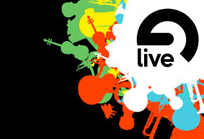On Wednesday, July 7, 2010 my piece Chromatic Textures was shown at 6X6 #5: Mystery, an exhibition at Ciné Lab in Athens, Georgia. My work was accepted along with five other artists, “…including Denton Crawford’s eyeballs, Aaron Oldenburg’s plunge into asphyxia, and a performance streamed live over the Internet from California.” Here’s my abstract for Chromatic Textures.
Chromatic Textures is a study on the synesthetic nature of our senses of sound and sight. Video input is used to produce generative musical phrases. The visual media is analyzed by the GMS (Gestural Music Sequencer) to create the musical forms in real-time. The software includes adjustable probability distribution maps for the scale and rhythm. Adjusting these settings allows familiar structures to emerge. The settings chosen for this piece cause notes within a particular scale to play more frequently, however, it is still possible for any note within the twelve-tone chromatic system to occur. As a result, dissonant or blue notes can be heard at rare instances throughout the piece.
Continue reading →
 I will be presenting and performing at the Minneapolis Ableton Live Users Group on December 8, 2009 at the Nomad in Minneapolis, Minnesota. In my presentation I’ll be showing what I do with custom built applications and Ableton Live, including the GMS and my new Wavetable Glitch Machine. Currently I interface my custom built applications with Live, using MIDI via the IAC drivers in Mac OS X, and Soundflower for audio. Soon I’ll be converting my audio based Max patches over to Max for Live, so I can use them in Live directly.
I will be presenting and performing at the Minneapolis Ableton Live Users Group on December 8, 2009 at the Nomad in Minneapolis, Minnesota. In my presentation I’ll be showing what I do with custom built applications and Ableton Live, including the GMS and my new Wavetable Glitch Machine. Currently I interface my custom built applications with Live, using MIDI via the IAC drivers in Mac OS X, and Soundflower for audio. Soon I’ll be converting my audio based Max patches over to Max for Live, so I can use them in Live directly.
Also appearing is Ali Momeni who’ll be showing some of his Max for Live patches, and JP Hungelmann who also organizes the event. Last time the group met it was held at IPR and there was an excellent turn out. The speakers were terrific and they gave away Ableton demo discs and t-shirts at the end of the event. If you use Live, have any interest in it, or electronic music in general, I highly recommend attending.
This second part to “Chromatic Currents” was produced with the GMS by using a string of lights placed into a large glass vase. I moved the camera around the vase to direct the flow of musical phrases with one hand while I adjusted transposition and note duration settings in the sequencer with my right.
You might notice that the video stimulus does not resemble lights in a vase. This is because I applied a negative filter to the video after capturing the performance. I used a pentatonic scale interspersed with rare dissonant notes and probability distributions in the note durations to give it an eerie awkwardness.
GMS: Chromatic Currents Part II from Unearthed Music on Vimeo.
Chromatic Currents Part I is a generative music piece driven by particles floating in a liquid. No intervention in particle behavior occurred while the piece was being performed using the GMS. The scale was strongly C minor pentatonic, weighted with a Dorian mode by adding less-likely probabilities for D and A. However, every note that was not part of the scale still had a small possibility of occurring. This led to occasional blue or dissonant pitches in the sequence. The possibility of occurrences for any note within a twelve tone chromatic scale led me to the title.
GMS: Chromatic Currents Part I from Unearthed Music on Vimeo.
Josh Clos produced this documentary short about the GMS recently. He and his colleagues Julie Kistler and Brian Smith shot video during my performance in Downtown Minneapolis with Minneapolis Art on Wheels on May 13, 2009. Later Josh interviewed me in the audio studio at Art Institutes Minnesota where I teach interactive media and audio production. As a student in my audio production class, Josh edited the sound and video together with minimal input from myself. His short illustrates what the GMS does and how I’ve been using it to compose music in real-time.
Examples of work in sound, imagery, and interaction
